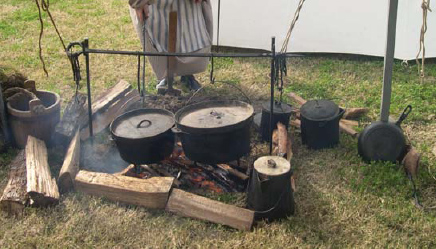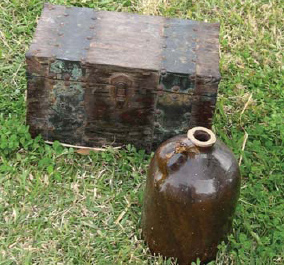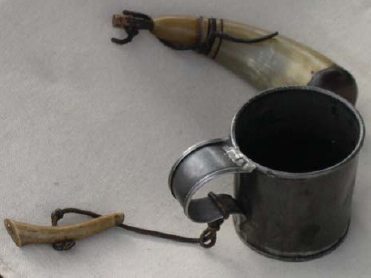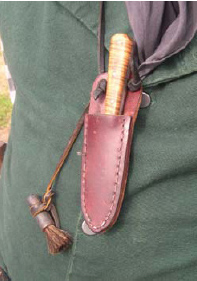
For most of the population everyday life on the southwestern frontier would be considered harsh by modern standards. Subsistence farming was the primary occupation, and many did not formally own the land that they farmed. Farming was a dawn-to-dusk, year-round occupation, with only a few slack periods when winter cold prevented outside work or when crops were well established in the growing season. Farms tended to be small, and there was considerable pressure for the often numerous children to establish their own families at an early age. These new families frequently moved farther west in search of land, pushing back the frontier.
The few affluent owners of large plantations or farms lived a considerably more luxurious lifestyle, with slaves, large homes, and luxuries such as musical instruments and fine, custom-made china. By the early part of the 19th century cities such as Nashville and Knoxville hosted educated professional classes of physicians, attorneys, and judges. A fairly high proportion of the population had at least some formal education at private schools, for which families of the students paid tuition in cash or trade items.9
For the militiaman, there was of course no everyday garrison life. He assembled at a regional muster point with his weapons and equipment, and embarked upon campaign as quickly as possible. The life of the soldier or militiaman on these campaigns, exposed to the elements, with limited medical care and an erratic food supply would today be cause for national outrage.
The militiaman, like his civilian counterpart, had no effective rain gear to protect him from the elements in a climate that averages 58in. (148cm) of rainfall each year. A heavy woolen coat with its natural oils provided the best protection against the elements, but through most of the year the militiaman was exposed to a natural wetting and drying cycle. In winters, during which temperatures are routinely below freezing, soldiers on campaign were protected from the cold only by coats made from old woolen blankets.
Housing in the field was at best a canvas fly that provided some protection from rain and none from the cold or wind. In settled camps the militiamen were expected to construct their own shelters from locally felled logs and whatever materials they could improvise. A major task of many volunteer and drafted militia units was to construct and garrison small forts that were used to secure supply lines and communication routes through the wilderness. These forts typically consisted of a small stockade built of upright pointed logs, with cabins for housing and storage for military supplies inside. Larger forts might have two-story log blockhouses for more secure defense. Militiamen were also used as labor to build simple roads or trails through the forest and to construct boats to transport supplies down the rivers that comprised the main transport routes.
There was no central quartermaster corps. Civilian contractors engaged by the Federal or state government handled logistics. These contractors purchased, transported, and distributed food and supplies under government contracts. All too often, states, or even the Federal government, would send a force into the field without adequate funding for their support. Supply wagons and the draft animals that pulled them were owned by the contractor, who was often reluctant to risk his property to capture or destruction by the enemy. As a result of this chaotic situation many units went short of supplies for protracted periods. Many commanders were quite frank in stating that they feared famine more than any enemy.
The simple issue of what was edible on campaign probably played a significant role in determining the soldiers’ diet. On campaign the basic diet of the militiaman consisted of salted meat, flour or meal, and a whiskey ration. Meat, preserved in brine and packaged in small barrels, consisted of pork, or less desirable, beef. Most militiamen would have been more familiar with pork in their daily diet, as easily raised pigs were the more common domestic food animals. The fat content of pork made it a better energy source, met more nutritional requirements, and was easier to chew than stringy beef. The problem of course was that preparation and preservation was hardly an exact science, and salted pork or bacon might be rancid.

Small groups of men, or messes, that might include both junior officers and enlisted men prepared communal meals using implements shown here. The most durable cooking ware was cast iron. Two Dutch ovens are shown being used as kettles to boil stews or soups. Hot coals could be placed in the dished lid and the pot used for baking. Also shown are two boiler pots, a skillet for frying, and a coffee pot. (Author)
Corn, or maize, was the staple grain crop of the frontier regions, but it was considered less desirable than wheat flour for baking bread for military purposes. Corn meal – finely ground dried corn – required that the grain be thoroughly dried in kilns before it was ground into meal, a process that might take weeks. Corn meal was used as a military ration, and in fact a shortage of meal delayed Jackson’s first campaign against the Creeks. Corn meal had the advantage that it could easily be baked or fried to produce bread.
Wheat flour was less common but probably more desirable as it produced bread that was easier to chew. Though more expensive, it was more useful as a military ration because it could be baked into hardtack biscuit. Hardtack, if protected from moisture and vermin, could be packed in barrels by contractors and shipped to the troops or carried in knapsacks. However, all too often the hardtack was not adequately packed or protected and thus might be ridden with weevils. Notoriously hard to chew, it could be soaked in water to soften or held in the mouth to dissolve. Hardtack biscuit was the basic “combat meal” of the period. One often-overlooked factor in the supply of troops in the field is dental hygiene. Tooth cleaning was not common, flour or meal contained bits of stone that wore away the teeth, and the only practical remedy for any dental problem was a painful extraction. This was an all-too-frequent, and unpleasant, aspect of life on campaign for both militiamen and regular soldiers.

Corn whiskey was distributed from jugs like this one, plugged with a simple cork. Senior officers used ironbound wooden chests like the one shown here to store and transport valuable personal possessions. (Author)

The ability to build a fire with flint and steel was a paramount skill. Small scraps of cloth or rope were placed in a metal can with a small hole, and put into a fire. Combustion in the oxygen-deficient environment produced carbonized tinder. Chunks of flint were valuable trade items, transported long distances. (Author)
This rather Spartan diet was probably augmented by other staples such as dried beans (although slow to prepare), dried fruit, and locally acquired foods. Food supplies captured from the Creeks were also gladly utilized, and in fact the Creeks probably ate a more diverse and healthy diet than the white settlers. Wild game including deer, turkey, and other birds, though relatively abundant, was unreliable as a food supply on campaign. Even for civilians wild game was not a major staple of the diet, simply because hunting was time consuming and often failed to produce enough food to warrant the effort.
Because of the limited transport for heavy cooking gear and the time involved, food preparation was done in small messes, or groups of men who would prepare communal meals over a wood fire. In militia units junior officers and enlisted men might belong to the same mess. Basic cooking gear consisted of civilian pots and pans, although records exist of Dutch ovens, used for baking over an open fire, supplied under contract. Mess gear consisted of a metal cup – an all-purpose tool for heating beverages, drinking, and eating. Plates might be simple metal pans or less expensive bowls carved from wood.
High-ranking officers had “camp waiters,” orderlies who attended to such menial tasks as cooking. These might be either hired men or slaves. Senior officers generally lived far better than the troops, with tents, and occasionally cots and camp furniture, though such luxuries were rare even for senior officers.

This drinking cup and flint knapper are typical of the militiaman’s simple gear. The flint knapper was made from bone or antler, and used to shape lumps of flint by chipping. The other object is a small powder horn. (Author)

The small camp knife was a multi-purpose tool used for eating, as a substitute for a screwdriver in repairing weapons, and for general utility tasks from cleaning fingernails to repairing clothing. This one is worn on a lanyard around the neck with a pan brush. (Author)
The ability to start a fire was a necessary skill, and most men carried flint and steel for the purpose. A common practice was to place old bits of cloth into a metal can with a small hole punched in it and place it into a fire. With limited oxygen the cloth would carbonize, producing easily ignited tinder for starting fires. If dry wood was available a knife could be used to produce fine wood shavings for tinder.
Disease and injury were facts of everyday life, not just in battle. Two classes of practitioners, physicians and surgeons, provided medical care. Physicians were generally more educated; they provided general care for disease and prescribed simple medications. Medications could be prepared by the physician or, in large towns, by an apothecary. Surgeons, who accompanied the troops, were generally practitioners of more rough and practical medicine: debriding and closing wounds, occasionally extracting bullets, and performing amputations. Probing and extraction of bullets was hazardous, and Jackson himself carried two pistol balls from duels embedded in his body, one near his heart, the other in his neck near his spine. Medical procedures were performed without effective anesthesia, and one of the duties of the surgeon’s mate, an enlisted specialty, was to help subdue patients.
Another military specialist was the clerk, who performed administrative tasks. The duties of the clerk were often nominal, since officers up to company grade were responsible for maintaining their own records. Military teamsters drove the teams of horses or mules that pulled gun carriages and wagons carrying specific military stores such as ammunition and tents. Their duties were strictly tactical, as contracted civilian teamsters drove most transport for general haulage.
Foremost among the issues that confronted militiamen – and particularly their leaders – was morale. Tedium and disenchantment were the greatest factors in reducing the combat effectiveness of militia units. Most militiamen quickly grew bored with camp life and were all too mindful of the needs of their farms and families. The disorganization of many early campaigns also led to disillusionment and poor morale as the troops stumbled about without bringing the enemy to conclusive battle. Jackson, for all his harsh disciplinary practices and hard campaigning, proved a popular leader because he actually fought – and won – battles.
9. As a teenager the ever-ambitious Sam Houston (later to become a military hero and eventually President of an independent Texas) operated one such single-room school near Knoxville.